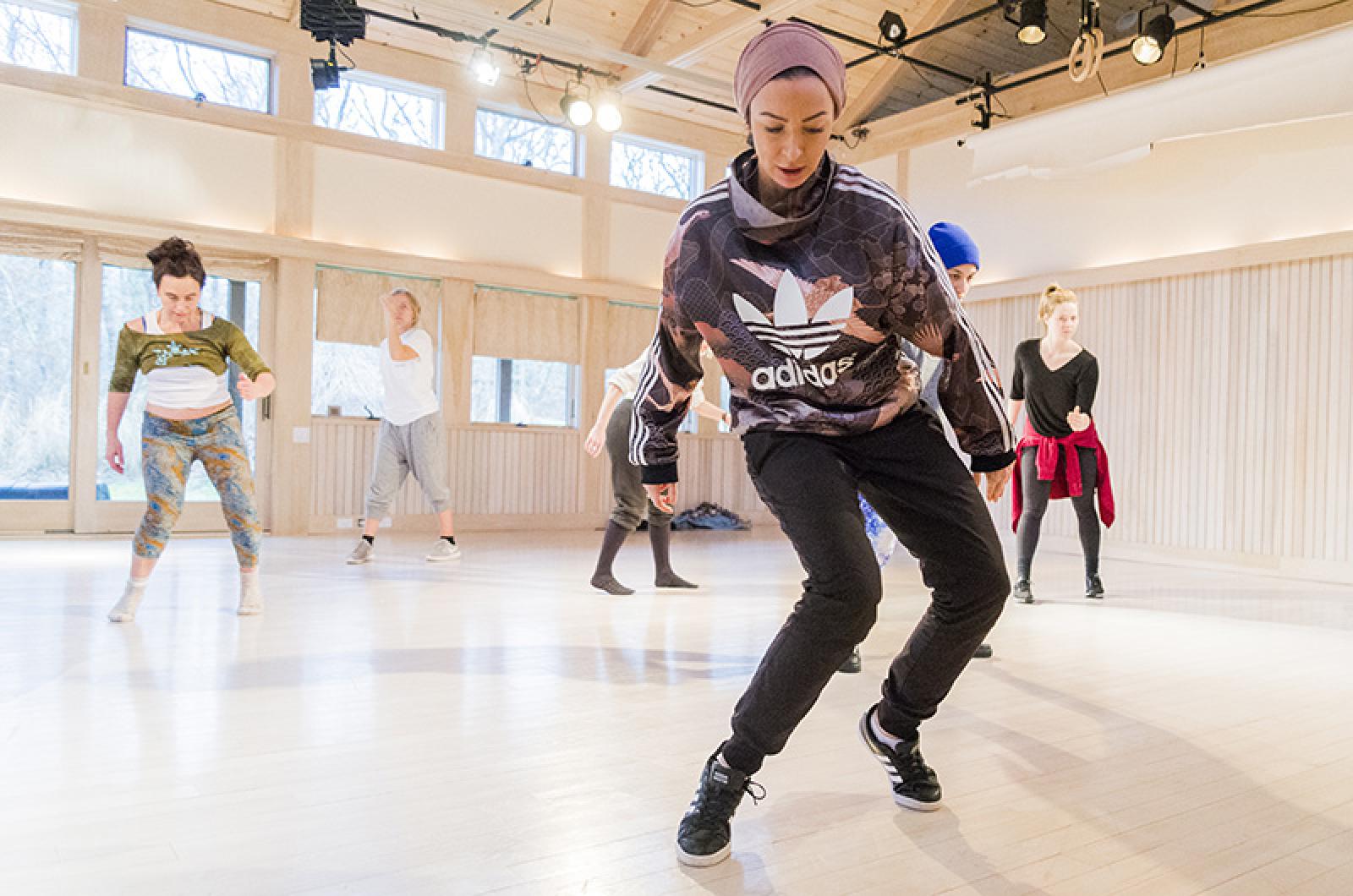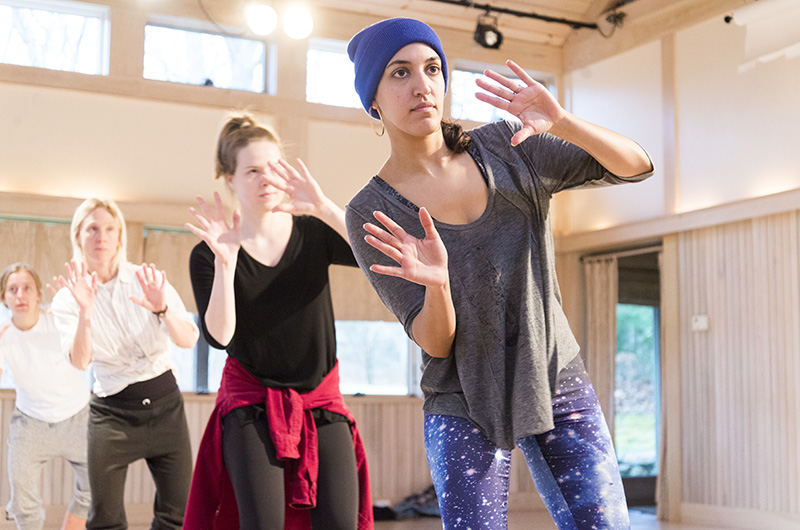When she was a baby and her father played jazz guitar, Amirah Sackett would shake with joy, moving her tiny arms to the music. When she was a bit older, her uncle took her to a wedding where she danced for so long she nearly fell asleep on the dance floor. At age 12, Ms. Sackett received a student of the month award at school with a space to put what she wanted to be when she grew up. She wrote: professional dancer.
Fast forward a few decades and Ms. Sackett, 43, is just that, using her passion for movement and identity as a Muslim American woman to challenge stereotypes and inspire audiences worldwide through hip-hop influenced works. Chicago based, Ms. Sackett will make her Vineyard premiere as part of the Yard’s winter series on Saturday at the Martha’s Vineyard Performing Arts Center. The performances are at 2 and 7 p.m.
Though her formal dance education was in ballet, Ms. Sackett said the freedom of hip-hop dance captivated her and she soon swapped out pirouettes for popping, locking and bopping.
“Hip hop was the revolutionary music of my youth,” she said during a rehearsal on the Island earlier this week.
Under the tutelage of her role model PopMaster Fabel, a Puerto Rican Muslim, Ms. Sackett continued her exploration of hip-hop and observed a connection between the movements of streetdance and the tenants of her faith.
“In hip-hop, we cypher,” she explained. “We have a circle. The idea of it is equality. When you go into the center all the energy is coming toward you when you dance. You have this unity of a lot of different cultures and socioeconomic groups coming together. In Islam, we’re all considered brothers and sisters in our faith and stand in a line to pray. A taxi driver can stand next to a doctor. In that moment you’re super united. I love having those two worlds make sense to me.”
While hip-hop and her faith exemplified unity, Ms. Sackett said she saw a growing discord in society between Muslims and non-Muslims, particularly in the years following the Sept. 11 attacks, driven by misconceptions and negative stereotypes. In 2011, Ms. Sackett decided to use her talents, and sense of humor, to launch a hip-hop dance troupe called We’re Muslim Don’t Panic to confront those prejudices and give audiences a true representation of Muslim identity.
“I realized they didn’t have the right understanding of both sides of things to talk about it and I felt I could be a bridge,” she said. “I think that getting people to talk to each other and know people different than them is the best way to find community and peace.”
Pushback came immediately from people taken aback by seeing a Muslim woman own her identity. As she prepared to perform her first solo work in sneakers and a niqab, a garment that covers the entire face except for the eyes, she said she knew she was taking a risk.
“People were telling me you are going to scare the entire audience,” she said. “I also knew Muslims wouldn’t be 100 per cent happy with that. I did it anyway because I guess I didn’t care. I’m living my truth.”
The performance, combining traditional Muslim attire with futuristic movements such as the robot, elicited such an emotional reaction from her audience that Ms. Sackett said she realized she had become part of something much larger than herself. She said Muslim girls came up to her after the show in tears, telling her it was inspiring to see someone who looked like them embodying their beliefs on stage.
“A lot of girls felt inspired by it and it made them feel proud and that they can be American and Muslim and live in that identity,” said Ms. Sackett. “I started to see this movement of Muslim women moving into different sectors and being visible. It was cool to realize that I’m a part of this, part of something bigger.”
A host of magazine interviews and a viral video later, Ms. Sackett now performs internationally and spends as much time as she can off-stage teaching hip-hop dance to students. She said visiting Vineyard classrooms of all ages has been one of the highlights of her two-week residency here. She added that although the Island doesn’t have an established Muslim population or mosque, her lessons are for anyone struggling with embracing who they are.
“It’s the most rewarding work of my life,” she said. “It hits on multiple levels and resonates with kids across the board. When you see someone who’s just owning it, it makes you feel like you can own it, too.”
Ms. Sackett said audiences can expect a “mystical” show this weekend inspired by the poetry of Rumi, a 13th century Islamic scholar. She said each of the three works mix modern movements and Rumi’s ancient words to present the rich history of the Islamic world in a contemporary setting.
“I felt that because Rumi is so popular with American audiences, I wanted to bring back his Muslimness. He represents that beautiful artistic side of Islamic thought,” she said.
Each piece also explores a universal theme of love, separation and unity. She said one of them will feature local dancers and depict the concept of “barzakh,” an Islamic concept of the space between life and death. Qadar, one of her two solo works, presents the struggle of losing someone you love, and facing a closed door to your dreams. In her other solo piece, Love Embraces All, Ms. Sackett said barriers will be broken and doors will open to find the community and peace that’s become her life’s mission.
“It’s about the borders we build within ourselves and around us and overcoming those and remembering to choose love, regardless of the struggle that we encounter,” she said.
Ms. Sackett said she hopes her joy and passion for dance will empower the audience to use their unique talents to proudly showcase their individuality. Most of all, she added, she just wants people to have fun and not be afraid to maybe show off their own moves after the show. “I hope it inspires people to dance,” she said. “That’s really what it’s all about.”
For tickets and further information, including video clips, visit dancetheyard.org.








Comments
Comment policy »